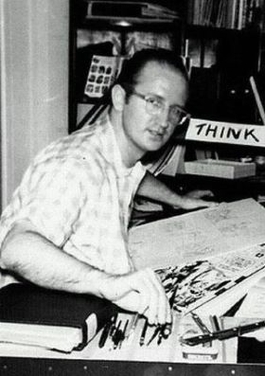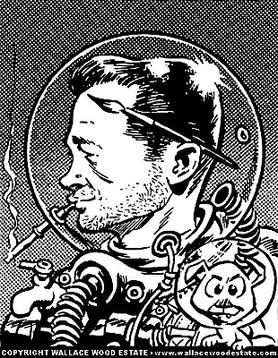
Stephen John Ditko was an American comics artist and writer best known for being the co-creator of Marvel superhero Spider-Man and creator of Doctor Strange. He also made notable contributions to the character of Iron Man, revolutionizing the character's red and yellow design.

Charlton Comics was an American comic-book publishing company that existed from 1945 to 1986, having begun under a different name: T. W. O. Charles Company, in 1940. It was based in Derby, Connecticut. The comic-book line was a division of Charlton Publications, which published magazines, puzzle books, and briefly, books. It had its own distribution company.

Amazing Adult Fantasy, retitled Amazing Fantasy in its final issue, is an American comic book anthology series published by Marvel Comics from 1961 through 1962, with the latter title revived with superhero features in 1995 and in the 2000s. The final 1960s issue, Amazing Fantasy #15, introduced the popular Marvel superhero Spider-Man. Amazing Adult Fantasy premiered with issue #7, taking over the numbering from Amazing Adventures.

T.H.U.N.D.E.R. Agents is a fictional team of superheroes that appeared in comic books originally published by Tower Comics in the 1960s. They were an arm of the United Nations and were notable for their depiction of the heroes as everyday people whose heroic careers were merely their day jobs. The series was also notable for featuring some of the better artists of the day, such as Wallace Wood and Gil Kane. The team first appeared in T.H.U.N.D.E.R. Agents #1. The name is an acronym for "The Higher United Nations Defense Enforcement Reserves". The team has appeared in several versions via several publishers since the early 1980s.

Wallace Allan Wood was an American comic book writer, artist and independent publisher, widely known for his work on EC Comics's titles such as Weird Science, Weird Fantasy, and MAD Magazine from its inception in 1952 until 1964, as well as for T.H.U.N.D.E.R. Agents, and work for Warren Publishing's Creepy. He drew a few early issues of Marvel's Daredevil and established the title character's distinctive red costume. Wood created and owned the long-running characters Sally Forth and Cannon.

Western Gunfighters is the name of two American Western-anthology comic book series published by Marvel Comics and its 1950s forerunner, Atlas Comics.

John Victor Romita was an American comic book artist best known for his work on Marvel Comics' The Amazing Spider-Man and for co-creating characters including Mary Jane Watson, the Punisher, Kingpin, Wolverine, and Luke Cage. Romita was the father of John Romita Jr., also a comic book artist, and the husband of Virginia Romita, who was for many years Marvel's traffic manager.

Bob Layton is an American comic book artist, writer, and editor. He is best known for his work on Marvel Comics titles such as Iron Man and Hercules, and for co-founding Valiant Comics with Jim Shooter.

witzend, published on an irregular schedule spanning decades, is an underground comic showcasing contributions by comic book professionals, leading illustrators and new artists. witzend was launched in 1966 by the writer-artist Wally Wood, who handed the reins to Bill Pearson from 1968 to 1985. The title was printed in lower-case.

Mr. A is a fictional comic book hero created by Steve Ditko. Unlike most of Ditko's work, the character of Mr. A remained the property of Ditko, who wrote and illustrated the stories in which the character appeared entirely himself. The character first appeared in Wally Wood's witzend #3 (1967).
William Pearson, known professionally as Bill Pearson, is an American novelist, publisher, editor, artist, comic book scripter and letterer, notable as the editor-publisher of his own graphic story publication, witzend.
Ralph Reese is an American artist who has illustrated for books, magazines, trading cards, comic books and comic strips, including a year drawing the Flash Gordon strip for King Features. Prolific from the 1960s to the 1990s, he is best known for his collaboration with Byron Preiss on the continuing feature "One Year Affair", serialized in the satiric magazine National Lampoon from 1973 to 1975 and then collected into a 1976 book.

E-Man is a comic-book character, a superhero created by writer Nicola Cuti and artist Joe Staton for the American company Charlton Comics in 1973. Although the character's original series was short-lived, the lightly humorous hero has become a cult classic occasionally revived by different independent comics publishers. The character was originally owned by Charlton but was eventually transferred to its creators.

Motion Picture Funnies Weekly is a 36-page American comic book created in 1939, and designed to be a promotional giveaway in movie theaters. While the idea proved unsuccessful, and only a handful of sample copies of issue #1 were printed, the periodical is historically important for introducing the enduring Marvel Comics character Namor the Sub-Mariner, created by writer-artist Bill Everett.
The "DC Explosion" and "DC Implosion" were two events in 1978 – the first an official marketing campaign, the second a sardonic reference to it – in which American comics company DC Comics expanded their roster of publications, then abruptly cut it back. The DC Explosion was part of an ongoing initiative at DC to regain market share by increasing the number of titles they published, while also increasing page counts and cover prices. The so-called "DC Implosion" was the result of the publisher experiencing losses that year due to a confluence of factors, and cancelling a large number of ongoing and planned series in response. The cancellations included long-running series such as Our Fighting Forces, Showcase, and House of Secrets; new series introduced as part of the expansion such as Firestorm and Steel: The Indestructible Man; and announced series such as The Vixen which would have been the company's first title starring an African-American woman. Former flagship series Detective Comics was also considered for cancellation. Some of the material already produced for these cancelled series was used in other publications. Several of the completed stories were "published" in small quantities as two issues of Cancelled Comics Cavalcade, whose title was a reference to DC's Golden-Age Comic Cavalcade series.

Doomsday + 1 is an American post-apocalyptic comic-book series that was published by Charlton Comics in the 1970s.

Samuel E. Grainger was an American comic book artist best known as a Marvel Comics inker during the 1960s and 1970s periods fans and historians call, respectively, the Silver Age and the Bronze Age of Comic Books. Series on which he worked include The Avengers, The Incredible Hulk and X-Men.
Michael Vosburg is an American comic book artist primarily known for his work on the Tales from the Crypt TV series.

Space Adventures is an American science-fiction anthology comic book series that was published sporadically by Charlton Comics from 1952 to 1979. Its initial iteration included some of the earliest work of industry notables Steve Ditko, Dick Giordano, and Tony Tallarico, and at least one story by EC Comics mainstay Bernard Krigstein.
The CPL Gang was a group of comic book enthusiasts who published a number of fanzines in the mid-1970s, including Contemporary Pictorial Literature (CPL) and Charlton Bullseye. Founded by Roger Stern and Bob Layton, the CPL Gang eventually included Roger Slifer, Duffy Vohland, Tony Isabella, Don Maitz, Michael Uslan, Steven Grant, and John Byrne, all of whom later became comics professionals.
















